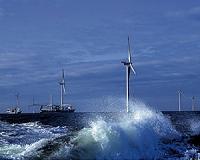 |
Washington (UPI) Aug 17, 2010 Researchers say ocean waves off the southern coast of Australia have the potential to generate as much as half of the country's current electricity needs. Interest is growing in wave energy as a viable source of renewable electricity generation as the world faces dwindling fossil fuels supplies, an American Institute of Physics release said Monday. Wave-energy developers, however, face the problem that all previous estimates of wave-energy potential were based on data from deep ocean waters, while "wave-energy generation systems are typically positioned near to shore," Australian physical oceanographer Mark Hemer says. In a journal article, Hemer and his colleagues have made new estimates of the wave-energy potential of Australia's southern near-shore regions, and have calculated what percentage of the country's energy needs could be supplied by wave energy alone. Hemer says if 10 percent of the near-shore wave energy available along Australia's Southern coastline could be converted into electricity, it could meet half of the country's present-day annual electricity consumption of 130,000 gigawatt-hours. Wave energy offers a "massive resource" to contribute to the Australian Government's aim of producing 45,000 gigawatt-hours a year of additional renewable energy before 2020, Hemer said. "Convert 10 percent of available wave energy from a 1000-km stretch in this area to electricity, " Hemer says, and "the quota could be achieved by wave energy alone."
Share This Article With Planet Earth
Related Links Powering The World in the 21st Century at Energy-Daily.com
 Which Type Of Electricity Generation Has The Least Impact On Climate?
Which Type Of Electricity Generation Has The Least Impact On Climate?Stuttgart, Germany (SPX) Aug 17, 2010 Coal-fired power stations burn lignite or, for the most part, coal imported from overseas. Solar cells need crystalline silicon that first needs to be extracted from quartz, an energy-intensive process. Therefore, when examining the climate compatibility of power generating plants, it makes sense to not restrict the analysis just to the operation of the plant. Instead, the total energy req ... read more |
|
| The content herein, unless otherwise known to be public domain, are Copyright 1995-2010 - SpaceDaily. AFP and UPI Wire Stories are copyright Agence France-Presse and United Press International. ESA Portal Reports are copyright European Space Agency. All NASA sourced material is public domain. Additional copyrights may apply in whole or part to other bona fide parties. Advertising does not imply endorsement,agreement or approval of any opinions, statements or information provided by SpaceDaily on any Web page published or hosted by SpaceDaily. Privacy Statement |